Having an ant infestation is problematic enough, but it can be even more troubling when you encounter flying ants. If you have winged ants in your home, they’ve either entered your home or they’ve come from a colony already inside your home and are trying to get out.
So, how to get rid of flying ants? You can employ natural remedies such as vinegar, tea tree oil, and soapy water. However, it’s more effective to use insecticide sprays, sticky tape, or bug zappers to first kill the insects and then setting up ant baits to kill off the entire colony.
In the following sections, we will answer common questions about flying ants, including whether they pose a threat, how to identify them, and the most effective ways to eliminate them.
Home Remedies for Flying Ants
If you’re looking for natural ways to get rid of flying ants or alternatives to chemical insecticides, here are some effective remedies:
Vinegar Solution
Mix equal parts of water and vinegar in a spray bottle and apply it directly to flying ants. The acidic nature of vinegar not only kills the ants but also repels other members of the colony. Use this solution on surfaces that won’t be damaged by vinegar.
Tea Tree Oil
Tea tree oil is a natural insecticide that kills and repels flying ants. Mix ten drops of tea tree oil with two cups of water and spray the solution directly onto the ants. However, be cautious when using tea tree oil around pets, as it can be toxic for them.
Soapy Water
Create a mixture of liquid dish soap and water in a spray bottle and spray it directly onto the flying ants. The soapy solution will cling to the ants’ exoskeletons and suffocate them.
Remember that although these methods are environmentally friendly, they may not be as effective in controlling large infestations compared to pesticides. If the problem persists, consulting a pest control professional may be necessary.
Related: How To Get Rid Of Ants Without Killing Them | Humane Remedies!
How to Get Rid of Flying Ants: Step-by-Step Instructions
Whether flying ants are inside or outside your home, getting rid of these pests will be a two-part process. This is because the flying ants are only a temporary symptom of a more enduring problem (an ant nest near your home).
How to Get Rid of Flying Ants Inside the House
- Use sticky tape, insecticide spray, or a bug zapper to kill any flying ants you see indoors.
- Use a vacuum cleaner with a nozzle attachment to remove dead bugs or bugs crawling on the floors and walls.
- Set up ant bait stations inside your home, especially where you see the most ant activity. Ants are attracted to food and water, so place the bait near moisture and food sources.
SaleTERRO Ant Killer Bait Stations T300B - Liquid Bait to Eliminate Ants - 12 Count Stations for Effective Indoor Ant Control
- ATTRACTS & KILLS: Effectively targets and eliminates common...
- KILLS THE ANTS YOU DON'T SEE: Terro ant bait is designed to share...
- FAST-ACTING: Noticeable ant activity reduction within days as...
- READY TO USE: Simply place ant baits indoors with no setup...
- VERSATILE HOME PLACEMENT: Ideal for use as terro ant traps along...
- Check the ant bait periodically to ensure it hasn’t dried out or become contaminated. Once the bait has been completely consumed, replace it with a fresh bait station in the same location.
- Be patient; the entire colony can take several weeks to be eliminated. Ants will carry the bait back to their nest, where it will be shared with the rest of the colony and eventually kill off the entire nest.
How to Get Rid of Flying Ants Nest Outside
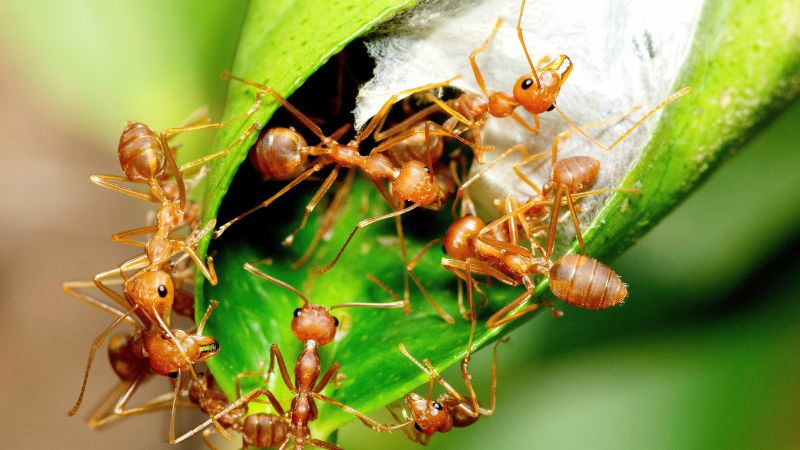
- Use a stationary bug zapper or insecticide spray to kill flying ants around the nest.
- Place ant bait stations near the ant nest to exterminate the entire colony. Make sure to use bait stations specifically designed for outdoor use.
- Use liquid and granular bait in each station to attract different species of ants. Place the bait near the nest and in areas with high ant activity.
- Check the bait stations weekly to ensure they haven’t dried out or become contaminated. Replace the bait as needed.
- Be patient, as it can take several days or weeks to eliminate the ant nest, depending on the level of infestation.
Best Flying Ant Killer Products
- ATTRACTS & KILLS: Effectively targets and eliminates common...
- KILLS THE ANTS YOU DON'T SEE: Terro ant bait is designed to share...
- FAST-ACTING: Noticeable ant activity reduction within days as...
- READY TO USE: Simply place ant baits indoors with no setup...
- VERSATILE HOME PLACEMENT: Ideal for use as terro ant traps along...
- Bug spray that quickly kills ants, roaches and flies
- Plant-based active ingredient bug killer safe for use around...
- Entomologist tested bug spray made with botanical extracts to...
- Bug killer for indoor and outdoor use, wherever bugs try to...
- Rooted in Nature, Optimized by Science
- Catch Flying Insects 24/7 - This flying insect trap uses blue and...
- Mess-Free Disposal - This indoor fly trap and gnat catcher uses a...
- Easy-to-Use - To use, remove the sheet from its adhesive backing,...
- Versatile Placement - You can place this plug in bug trap in your...
- Includes 1 Plug-In Device and 1 Cartridge - This plug in fly trap...
- KILLS TERMITES AND CARPENTER ANTS: Indoor plus home foundation...
- FOR INDOOR AND OUTDOOR USE: Up to 9 months control indoors
- KILLS CARPENTER BEES: Kills wood-destroying insects on contact.
- CLEAR FORMULA: Non-staining spray leaves no odor.
- ACCUSHOT SPRAYER: Continuous power sprayer for precise...
- ATTRACTS & KILLS ANTS: TERRO ant killer attracts and kills common...
- FAST-ACTING RESULTS: Notice a significant decrease in ant...
- SAME BAIT, IMPROVED DESIGN: The new and improved liquid ant traps...
- READY TO USE: The pre-filled sugar ant traps indoor are easy to...
- DISCREET PLACEMENT: Lay flat or use the included foam adhesive...
- EFFECTIVE ANT ELIMINATION: Terro outdoor liquid ant baits attract...
- COLONY CONTROL: Worker ants carry Terro ant bait back to the...
- FAST-ACTING RESULTS: With the use of Terro ant killer, experience...
- SIMPLE SETUP: Terro outdoor ant bait is easy to use with insert...
- OUTDOOR PROTECTION: Place Terro ant bait stations outdoors to...
What Are Flying Ants?
Flying ants are not separate species of ant but male and female ants that have reached sexual maturity. These ants remain in the ant nest for most of their lives until it’s time to disperse and find a mate.
- Identification: Flying ants have two pairs of wings, with the front wings longer than the back. They have small waists and bent antennae, ranging in color from brown or black to red.
- Attraction to Light: Like many insects, lights attract flying ants. This behavior is thought to be related to their use of the sun as a navigational tool. If you see a flying ant swarm nearby, it’s best to turn off the lights in your home.
Related: What Attracts Ants? Information and Facts
- Lifespan: Male ants live up to only a week after mating with the queen while females live up to several months and worker ants live up to 7 years. Queens, on the other hand, are able to live up to 30 years in their respective colonies.
Related: Ant Lifespan: Information and Facts
Can Queen Ants Fly?
After mating, female flying ants lose their wings and become queens. The queen no longer needs her wings as she spends the rest of her life underground, laying eggs for her colony.
Do Flying Ants Eat Wood? | What Do Flying Ants Eat?
Flying ants have no interest in eating and only sprout wings to find a mate. Once they mate, the male ants die, and the females fly to a new location to start their colonies. Their offspring will be responsible for bringing them food.
Can Flying Ants Cause Damage?
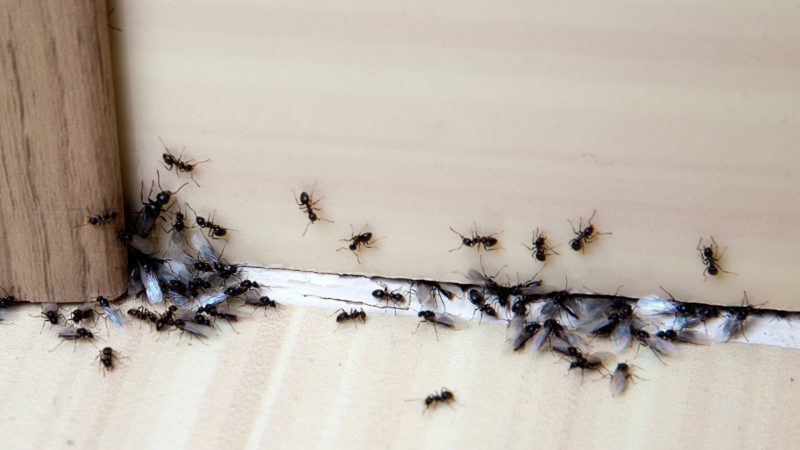
While most of them are harmless, seeing them in your home could indicate an ant infestation. Flying ants are the reproductive members of an ant colony, so if you see them inside your home, it’s a sign that the colony is nearby. Ant infestations can be a nuisance and may result in spoiled food and pest control expenses.
The carpenter ant is the only species of ant that can cause structural damage to a home. These ants burrow into wood to make their nests, which can weaken the wood over time. If you spot flying carpenter ants, it means that a carpenter ant colony is nearby and may be causing damage to your home.
Related: How to Get Rid of Ants | Safe and Effective Methods
Types of Flying Ants
Flying Carpenter Ants
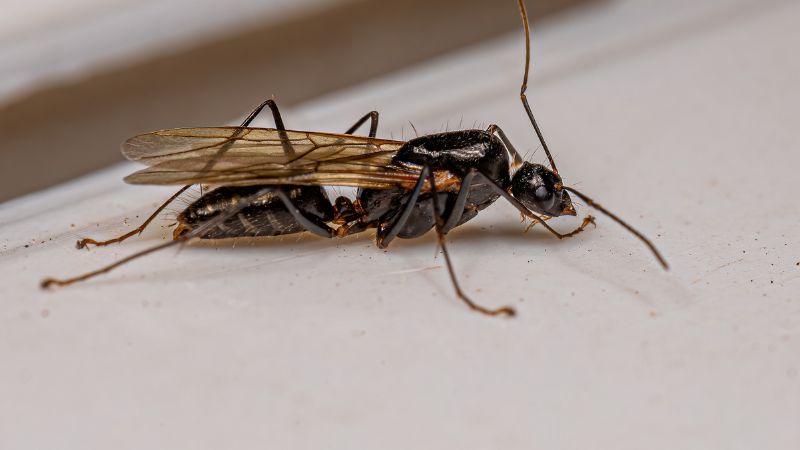
These ants can be identified by their large size and black or reddish-brown color. They nest in wood and can cause damage to homes if not treated promptly.
Related: How to Get Rid of Carpenter Ants Without an Exterminator
Flying Red Ants
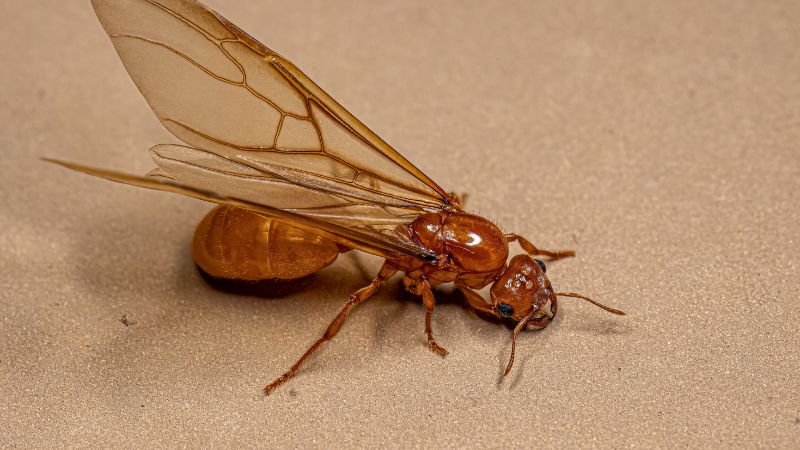
These are likely fire ants, a common and aggressive group of ants in the United States, belonging to the genus Solenopsis. They have a reddish-brown color and can deliver painful stings.
Black Flying Ants
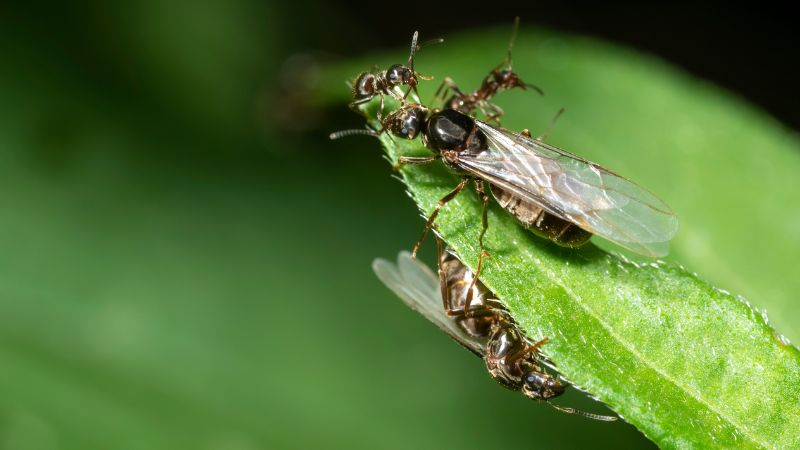
These ants can belong to various species, such as the little black ant or black garden ant. They are generally harmless but can invade kitchens in search of food.
Difference Between Flying Ants and Termites
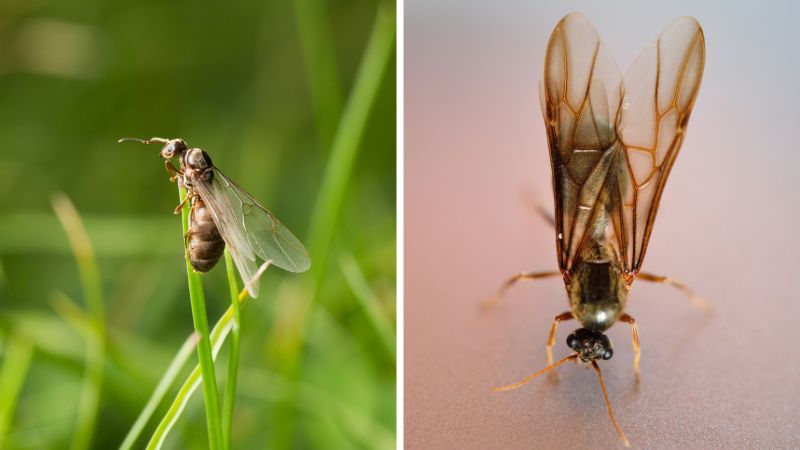
Knowing the difference between flying ants and termites is important, as termites can cause serious damage to homes. Here are some key distinctions:
- Wings: Both flying ants and termites have two pairs of wings, but a termite’s wings are equal in length, while a flying ant’s front wings are longer than its back wings.
- Body Shape: Flying ants have a narrow, pinched waist that separates their thorax and abdomen, while termites have a straight, broad body shape.
Other Bugs That Look Like Flying Ants

- Dirt daubers: These are wasps with a slender waist and a dark color. They can sting if provoked and build mud nests.
- Snake flies: These insects have elongated bodies and two pairs of wings of equal size. They are not aggressive and are mostly harmless.
- Black carpenter bees: These bees are wider and have oblong-shaped heads compared to flying ants. They can cause damage to wood but are generally not serious pests.
Do Flying Ants Bite?
It depends on the ant species. Some species, such as carpenter ants, crazy ants, and field ants are more likely to bite. Other species, such as flying fire ants, harvesters, and acrobat ants, are more likely to sting.
If you are bitten or stung by a flying ant, follow these steps:
- Wash the affected area with soap and water to remove any dirt or bacteria that could cause an infection.
- Refrain from touching or scratching the bite, which could worsen the itching and inflammation.
- Apply hydrocortisone cream or take an antihistamine to alleviate any discomfort or itching.
- In rare cases, ant bites or stings can cause anaphylactic shock, a severe allergic reaction that requires immediate medical attention. If you experience throat, lips, or tongue swelling, hives, dizziness or fainting, shortness of breath, or stomach pain, seek emergency medical help.
Related: How to Get Rid of Ants in Hot Tub | A Complete Guide
Prevention Tips
Flying ants can enter your home in two ways: they will fly in through windows, crawl through cracks, or come from a colony already inside your home. To prevent flying ants from entering your home, follow these steps:
- Seal up any cracks in your windows and doors. Inspect the perimeter around each window and door in your home thoroughly, and use a caulking gun to seal any cracks.
- Store food properly. While flying ants primarily focus on mating, the rest of their colony is still searching for food. Storing your food in sealed, airtight containers is important to prevent ant colonies from entering your home. When possible, store fresh fruit and vegetables in the refrigerator.
Related: Flying Ants in Pool: How to Keep Them Away | Tips & Guide
List of Sources
Davis, H. (2008). Winged Ants and Termites in the House.
Maryland Department of Agriculture. (n.d.). Termites and Ants.
Michigan State University. (n.d.). Winged Carpenter Ants.
University of Wisconsin-Milwaukee. (2017). Flying Ants.
- Bed Bug Surge 2025: How to Detect, Prevent, and Safely Eliminate Infestations in Top U.S. Cities - June 18, 2025
- Asian Needle Ants Invade US Homes: 2025 Guide to Identification, Risks, and Effective Control - June 11, 2025
- New World Screwworm Alert: How US Livestock Owners Can Prevent Outbreaks and Protect Herds [Summer 2025 Update] - June 8, 2025







